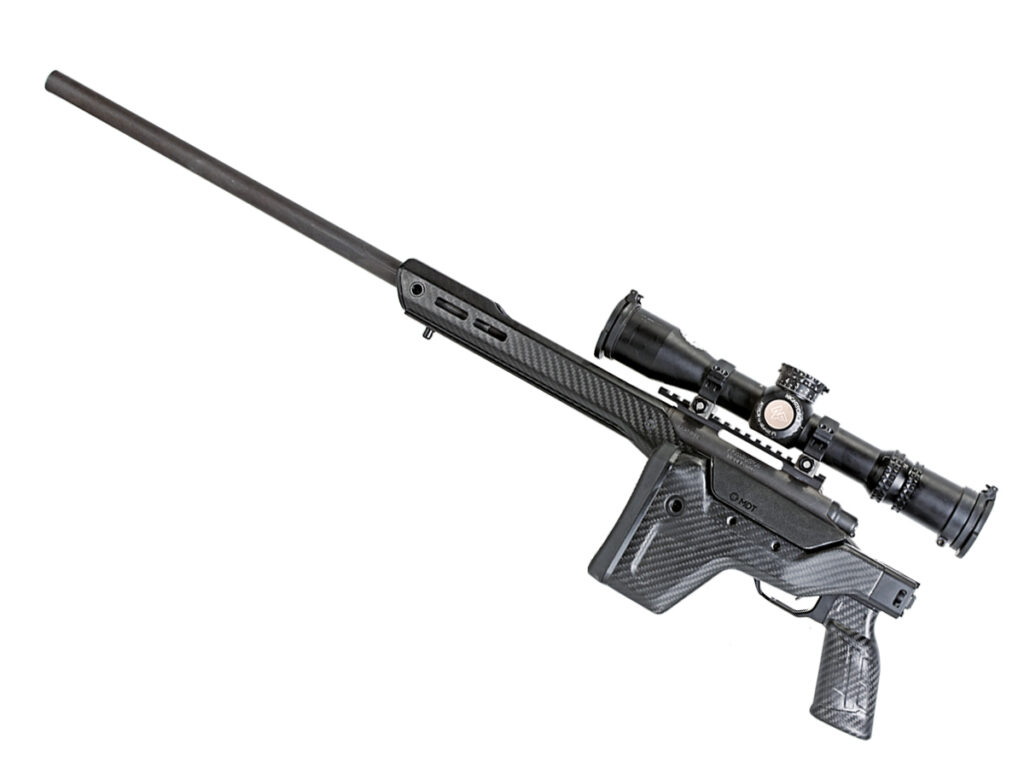At CarnivoreWeb.com, we independently review products and outfitters. However, we may earn a commission when you purchase products through links on our site. Read our affiliate policy. Read about how we test products.
While we all like a bit of blued steel and walnut in our lives, there’s no debating the benefits of carbon fiber and magnesium
MDT have made a name for themselves in the rarefied world of precision rifle competition, where their chassis systems for Remington, Savage, and Tikka actions have earned an enviable reputation, as well as a long list of podium finishes. It’s not uncommon for PRS rifles to tip the scales at over 20 pounds, which makes them a royal pain to carry for any length of time, and pretty much rules them out for use in the hunting field, apart from a few very specialized applications. By whittling away at some of their competition designs and taking a hard look at material selection, the company has come up with a means of incorporating all the benefits and features of a chassis rifle, without all the weight.
The base model tips the scales at just 26 ounces and offers V block bedding, AICS magazine compatibility, adjustable length of pull, and an adjustable comb. Step up to the folding stock version with an ARCA rail, and you add 5 ounces to the scales, but gain a lot more in terms of practicality. We’re fans of folding stocks on hunting rifles, as they make the gun considerably easier to transport through the woods when strapped to a pack. This goes double for when a suppressor is installed.

The heart of the chassis is machined from AZ61A magnesium alloy, which is about 45-percent lighter than 7075 aluminum, while still maintaining decent strength. The buttstock, forend, and pistol grip are then attached to this center section, which also comprises the magwell, trigger guard, and magazine release. Although there are lightening cuts subtly worked into the design, there’s still plenty of material left where it matters to counteract torque and flex. For those who shoot with an open grip, there’s a shelf on both sides above the AR-15-style pistol grip to anchor your thumb. The magazine release can be activated with the trigger finger without moving your master hand.
The forend is comprised a 2-inch diameter carbon-fiber tube, relieved for around 8 inches above the barrel and, in our sample, with an ARCA rail below. The last 3.25 inches provide mounting surfaces for a clip-on optic, should you want to install one in front of your primary, and the tube is capped with a machined aluminum reinforcement to resist crushing at its weakest point. At the other end of the chassis, the folding buttstock features an adjustable comb with a thin, closed-cell foam pad to insulate your cheek from chilly carbon fiber. Length of pull is set by means of spacers. Four QD sling sockets are incorporated on the sides of the chassis, as well as one conventional sling stud at the 6 o’clock position for those who use Harris-style bipods. The folding stock’s double hinge mechanism locks up tight with a minimum of play in the lateral direction and next to zero in the vertical.
We tested it for ease of installation using a heavy-barreled R700 action, figuring that if it could accept this then a sporter profile would be a chip shot. Putting the parts together took about three minutes flat and once the action screws were tightened, there was no slop or play detectable anywhere. Given its light weight, ease of assembly, quality of components and versatility that a completely adjustable chassis system offers, we reckon we might just have found the basis for our next hunting rifle.
- MSRP: $1,400
- Website: mdttac.com
Editor’s Note: This article originally appeared in Carnivore Magazine Issue 6.
Why You Can Trust CARNIVORE
Since its launch, CarnivoreWeb.com has been a trusted authority on hunting, fishing and wild food, delivering expert insight for outdoorsmen who live the field-to-table lifestyle. More than a hunting and fishing site, CarnivoreWeb.com covers the full spectrum of the modern outdoors—from rifles, bows, and fishing gear to cooking, conservation and adventure.
Our contributors are drawn from across the hunting and angling world, including seasoned guides, lifelong hunters, competitive shooters and outdoor writers with decades of field experience. Every review, article and feature is built on firsthand testing, deep research, and an unwavering commitment to accuracy.
Commitment to Journalistic Principles
At CarnivoreWeb.com, upholding journalistic integrity is our top priority. We follow strict editorial standards to ensure all content is accurate, transparent, and unbiased. Our editors and writers operate independently, free from outside influence, advertisers or stakeholders. We adhere to established journalistic codes of ethics, holding ourselves accountable for the information we publish, correcting errors when they occur and disclosing any potential conflicts of interest.
This commitment ensures that our readers can trust CarnivoreWeb.com to provide reliable, honest coverage that helps them make informed decisions—whether selecting gear, honing outdoor skills or preparing wild game.
Find out more about our Editorial Standards and Evaluation Process


